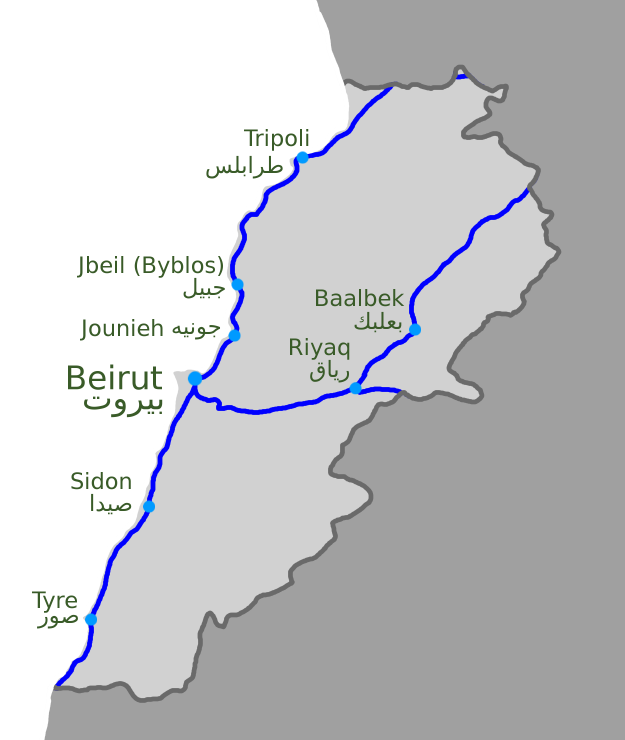|
Beirut Tramway
Beirut maintained a public tramway from the early to mid 20th century. The first tramline was developed under the Ottoman rule and continued operation under the French Mandate up to the 1960s, as modern automobiles became widely adopted. With the problem of congestion and severe traffic jams caused by the explosion of cars in the Beirut Metropolitan area, trams have been proposed as a possible solution. History The tramway system in Beirut opened in April 1908 and lasted until September 1965. The golden age of the Beirut Tram saw it cover 12 Kilometers around Beirut's center in 1931. As automobiles became more widely adopted, tram tracks were removed to give way for more cars until the tram was fully decommissioned in September 1968. Gallery Beirut, Rue Basta.jpg, Terminus on Basta Street, 1925 Beirut Tramway in Bliss Street.jpg, Line 2 tram in Bliss Street, 1940s Straatbeeld in Beiroet, Bestanddeelnr 255-6195.jpg, Line 3 tram, 1950s Beirut Tramways 1961.svg, Network plan, 19 ... [...More Info...] [...Related Items...] OR: [Wikipedia] [Google] [Baidu] |
Beirut
Beirut ( ; ) is the Capital city, capital and largest city of Lebanon. , Greater Beirut has a population of 2.5 million, just under half of Lebanon's population, which makes it the List of largest cities in the Levant region by population, fourth-largest city in the Levant region and the List of largest cities in the Arab world, sixteenth-largest in the Arab world. The city is situated on a peninsula at the midpoint of Lebanon's Mediterranean Sea, Mediterranean coast. Beirut has been inhabited for more than 5,000 years, making it one of the List of oldest continuously inhabited cities, oldest cities in the world. Beirut is Lebanon's seat of government and plays a central role in the Economy of Lebanon, Lebanese economy, with many banks and corporations based in the city. Beirut is an important Port of Beirut, seaport for the country and region, and rated a Global City, Beta- World City by the Globalization and World Cities Research Network. Beirut was severely damaged by ... [...More Info...] [...Related Items...] OR: [Wikipedia] [Google] [Baidu] |
Tram
A tram (also known as a streetcar or trolley in Canada and the United States) is an urban rail transit in which Rolling stock, vehicles, whether individual railcars or multiple-unit trains, run on tramway tracks on urban public streets; some include segments on segregated Right-of-way (property access), right-of-way. The tramlines or tram networks operated as public transport are called tramways or simply trams/streetcars. Because of their close similarities, trams are commonly included in the wider term ''light rail'', which also includes systems separated from other traffic. Tram vehicles are usually lighter and shorter than Main line (railway), main line and rapid transit trains. Most trams use electrical power, usually fed by a Pantograph (transport), pantograph sliding on an overhead line; older systems may use a trolley pole or a bow collector. In some cases, a contact shoe on a third rail is used. If necessary, they may have dual power systems—electricity in city stre ... [...More Info...] [...Related Items...] OR: [Wikipedia] [Google] [Baidu] |
French Mandate
The Mandate for Syria and the Lebanon (; , also referred to as the Levant States; 1923−1946) was a League of Nations mandate founded in the aftermath of the First World War and the partitioning of the Ottoman Empire, concerning the territories of Syria and Lebanon. The mandate system was supposed to differ from colonialism, with the governing country intended to act as a trustee until the inhabitants were considered eligible for self-government. At that point, the mandate would terminate and a sovereign state would be born. During the two years that followed the end of the war in 1918—and in accordance with the Sykes–Picot Agreement signed by the United Kingdom and France during the war—the British held control of most of Ottoman Iraq (now Iraq) and the southern part of Ottoman Syria (now Israel, Palestine and Transjordan), while the French controlled the rest of Ottoman Syria (including Lebanon, Alexandretta, and portions of Cilicia). In the early 1920s, British ... [...More Info...] [...Related Items...] OR: [Wikipedia] [Google] [Baidu] |
Rail Transport In Lebanon
Rail transport in Lebanon began in the 1890s as French Third Republic, French projects under the Ottoman Empire but largely ceased in the 1970s owing to the country's Lebanese Civil War, civil war. The last remaining routes ended for economic reasons in the 1990s. At its peak Lebanon had about of railway. History Ottoman Empire Beirut and Damascus were first connected by telegraph in 1861 and by a macadam road in 1863. Rail transport in Syria, Syrian railways connecting the two cities ( over the crest of the Mount Lebanon range) or another port were planned as early as 1871 but were not enacted. In 1889, the Ammiyya Revolt broke out among the Druze and other Ottoman Syria, Syrian farmers. The Ottoman response to the insurrection included a number of railway concessions—quickly sold to foreign interests—to improve the development and centralized control of the region. Hasan Beyhum Efendi received a concession to construct a Tramway (industrial), tramway between Bei ... [...More Info...] [...Related Items...] OR: [Wikipedia] [Google] [Baidu] |



